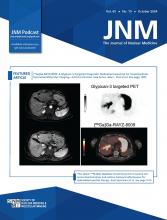Visual Abstract
Abstract
Neoadjuvant therapy in patients with locally advanced rectal cancer (LARC) has achieved good pathologic complete response (pCR) rates, potentially eliminating the need for surgical intervention. This study investigated preoperative methods for predicting pCR after neoadjuvant short-course radiotherapy (SCRT) combined with immunochemotherapy. Methods: Treatment-naïve patients with histologically confirmed LARC were enrolled from February 2023 to July 2023. Before surgery, the patients received neoadjuvant SCRT followed by 2 cycles of capecitabine and oxaliplatin plus camrelizumab. 68Ga-labeled fibroblast activation protein inhibitor ([68Ga]Ga-FAPI-04) PET/MRI, [18F]FDG PET/CT, and contrast-enhanced MRI were performed before treatment initiation and before surgery in each patient. PET and MRI features and the size and number of lesions were also collected from each scan. Each parameter’s sensitivity, specificity, and diagnostic cutoff were derived via receiver-operating-characteristic curve analysis. Results: Twenty eligible patients (13 men, 7 women; mean age, 60.2 y) were enrolled and completed the entire trial, and all patients had proficient mismatch repair or microsatellite-stable LARC. A postoperative pCR was achieved in 9 patients (45.0%). In the visual evaluation, both [68Ga]Ga-FAPI-04 PET/MRI and [18F]FDG PET/CT were limited to forecasting pCR. Contrast-enhanced MRI had a low sensitivity of 55.56% to predict pCR. In the quantitative evaluation, [68Ga]Ga-FAPI-04 change in SULpeak percentage, where SULpeak is SUVpeak standardized by lean body mass, had the largest area under the curve (0.929) with high specificity (sensitivity, 77.78%; specificity, 100.0%; cutoff, 63.92%). Conclusion: [68Ga]Ga-FAPI-04 PET/MRI is a promising imaging modality for predicting pCR after SCRT combined with immunochemotherapy. The SULpeak decrease exceeding 63.92% may provide valuable guidance in selecting patients who can forgo surgery after neoadjuvant therapy.
- © 2024 by the Society of Nuclear Medicine and Molecular Imaging.
This article requires a subscription to view the full text. If you have a subscription you may use the login form below to view the article. Access to this article can also be purchased.
SNMMI members
Login to the site using your SNMMI member credentials
Individuals
Login as an individual user








